Understanding Freeze Proof Cattle Watering Systems
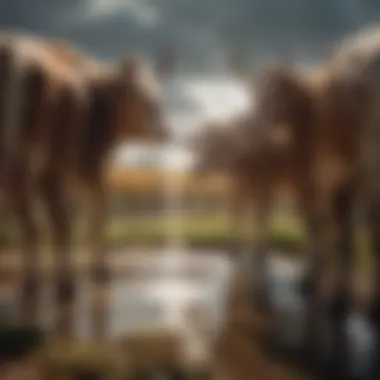

Overview of the Topic
Definition and Importance
Freeze proof cattle watering systems are engineered solutions designed to provide livestock with continuous access to water during cold weather. These systems prevent the water from freezing, ensuring that cattle can hydrate without interruption. The importance of these systems cannot be overstated. Access to fresh water is essential for the health and productivity of livestock. During winter months, traditional watering methods often fail, risking the welfare of animals and potentially leading to economic losses for farmers.
Current Trends
The agricultural sector is increasingly adopting innovative technologies to enhance cattle watering solutions. Current trends include the integration of heated water tanks, insulated waterers, and solar-powered systems. These advancements help to maintain water at optimal temperatures while minimizing energy costs. Farmers are placing a greater emphasis on sustainability, seeking systems that not only provide reliable water sources but also reduce environmental impact. As climate change continues to pose challenges, the demand for effective freeze-proof solutions is growing.
Key Techniques and Practices
Step-by-Step Guide
Implementing a freeze proof cattle watering system involves several key steps:
- Assess the Location: Evaluate the existing setup to determine the best type of system for the specific environment.
- Select the System Type: Choose from various options such as insulated tanks, heated bowls, or underground piping.
- Install the System: Follow manufacturer's guidelines to ensure proper installation. If using a heated system, verify electrical connections are safe.
- Conduct Regular Maintenance: Frequently inspect the system for any signs of wear or malfunction. Ensure heaters and insulation remain effective.
- Monitor Water Quality: Regular checks on water clarity and temperature are crucial, especially in extreme weather.
Tools and Equipment Needed
When setting up a freeze proof watering system, you will need:
- Quality insulated waterers or tanks
- Heating elements, such as electric heaters
- Adequate power supply solutions
- Insulation materials for exposed pipes
- Basic tools for installation, including wrenches and screwdrivers
Challenges and Solutions
Common Obstacles
Farmers face several challenges with freeze proof watering systems. Some common obstacles include:
- High installation and operational costs.
- The need for skilled labor to install complex systems.
- Potential electrical hazards with heated systems.
- Lack of access to reliable power sources in remote areas.
Innovative Solutions
To address these challenges, innovative solutions are emerging:
- Alternative Energy Sources: Utilizing solar panels can minimize reliance on traditional power while reducing costs.
- Smart Technology: Remote monitoring systems can alert farmers to water temperature changes, ensuring immediate action can be taken.
- Community Resources: Collaborating with local agricultural organizations can provide valuable support in sharing resources and knowledge.
Proper understanding and implementation of freeze proof cattle watering systems can lead to better livestock health, increased productivity, and overall farm sustainability.
Prologue to Freeze Proof Cattle Watering Systems
Water is an essential resource for livestock health and productivity. This significance escalates during the winter months when cold weather poses challenges to water access. Freeze proof cattle watering systems emerge as a crucial solution. These systems ensure that livestock have continuous access to water, even in extreme temperatures.
Importance of Water Access for Livestock
Water quality and availability directly impact the health of cattle. Cattle require adequate water intake to maintain their physiology and productivity. Insufficient water consumption can lead to dehydration, decreased milk production, and poor weight gain. In a well-managed herd, the provision of clean and accessible water is paramount.
During harsh winters, traditional water sources such as troughs and ponds may freeze, complicating water access. Investing in freeze proof systems not only safeguards the animals’ health but also optimizes overall farm operations. These systems can include solutions like heated troughs and self-contained systems that ensure water remains in a liquid state under freezing conditions.
Impact of Cold Weather on Water Sources
Cold weather significantly affects various water sources. Frozen surfaces can render natural water sources ineffective, placing stress on both animals and farmers. When temperatures dip below freezing, water supply routines may become labor-intensive. Daily monitoring and manual water provision may be necessary, which can lead to increased labor costs and logistical challenges.
The dependency on conventional water sources often results in uneven distribution of water to livestock, especially in larger operations. Addressing these challenges through modern systems not only mitigates the risk of livestock dehydration but also streamlines the watering process. A systematic approach to maintaining water availability allows farmers to focus on other critical farm management tasks.
"Consistent access to water is not just a luxury; it's a necessity for optimal livestock performance, especially in unforgiving winter months."
Types of Freeze Proof Cattle Watering Systems
In regions where temperatures drop significantly, ensuring a reliable source of water for livestock becomes crucial. The types of freeze proof cattle watering systems play a substantial role in achieving this objective. Selectting the right type of system can directly impact the health, productivity, and overall welfare of livestock during harsh winter months. Each type of system offers unique benefits, considerations, and challenges for farmers. Understanding these systems helps ensure that livestock have continuous access to water, which is essential for their survival and growth.
Heated Water Troughs
Heated water troughs are among the most common solutions for preventing water from freezing. These troughs combine traditional water storage with integrated heating elements. The heating can come from electricity or solar energy.
- Advantages of Heated Troughs:
- Considerations:
- Consistency: Maintain water temperature above freezing, ensuring availability for the animals.
- Low Maintenance: Once installed, they generally require minimal upkeep.
- Easy Installation: Many models are straightforward to install, often needing no special tools.
- Energy Source: Dependence on electricity can be a concern during power outages.
- Initial Costs: The upfront investment for heated troughs can be higher compared to other systems.
Self-Contained Systems
Self-contained systems integrate heating and water storage in one unit. These systems are designed to be mobile and efficient. They often feature built-in heating mechanisms that prevent freezes, making them ideal for remote or varied configurations on farms.
- Key Features:
- Benefits:
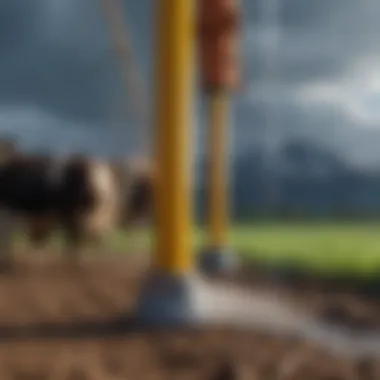
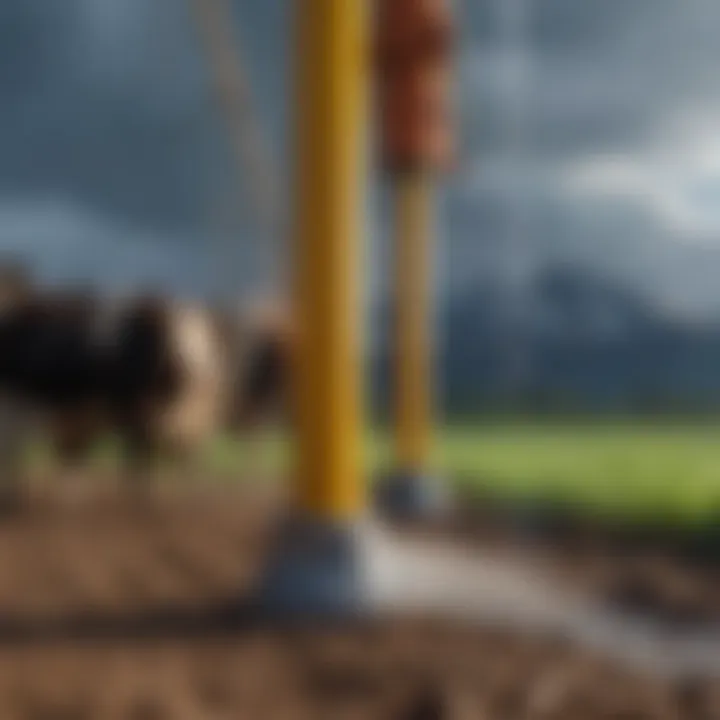
- Fully insulated construction helps maintain water temperature.
- Some models have automatic filling capabilities, reducing labor needs.
- Portable: Easily moved to different locations based on livestock needs.
- All-in-One: Combines multiple functions, saving space and cost in the long run.
Gravity-Fed Solutions
Gravity-fed solutions utilize natural gradients to provide water to cattle. This system relies on elevated water sources, allowing water to flow down to troughs or watering stations. While less common in very cold areas because of possible freezing, it can still be effective when properly designed.
- Components Involved:
- Advantages:
- Elevation: A robust water source needs to be positioned higher than the troughs.
- Insulated Piping: Protects the water from freezing as it travels.
- Energy Efficient: Doesn't require power for operation.
- Low Overhead: The system can be less expensive over the long term since no moving parts need replacement.
Insulated Water Delivery Piping
Insulated piping is essential for delivering water from a source to troughs, particularly in areas where temperatures can drop significantly. Good insulation prevents water from freezing during transit.
- Design Features:
- Benefits:
- Thick insulation material is critical to maintaining temperature.
- Flexible options can adjust to various landscaping.
- Cost-Effective: Reduces the risk of freeze damage to piping systems.
- Long-Term Reliability: Properly insulated pipes can last considerably longer than non-insulated ones.
Key Components of Freeze Proof Systems
The effectiveness of freeze proof cattle watering systems relies heavily on their core components. Each element contributes significantly to ensuring a reliable water supply during inclement weather. Understanding these components allows farmers to select the right systems and maintain them effectively. By focusing on heating elements, thermostats, and insulation materials, we can highlight how they each bolster system performance and longevity.
Heating Elements and Technologies
Heating elements are crucial in preventing water from freezing. These components maintain a consistent temperature, ensuring that livestock always have access to liquid water. There are different technologies involved, ranging from traditional electrical heating elements to more advanced options such as heated water bowls or circulating water systems.
- Electrical Heating Elements: These are commonly used due to their simplicity. They can be installed in troughs directly to keep the water warm.
- Solar-Powered Solutions: These are gaining popularity, especially in remote locations. They use solar panels to power heating elements, cutting energy costs.
- Hydronic Heating: This technique involves running warm water through pipes to keep water in troughs at optimal temperatures. It is effective but requires a well-designed system.
Farmers must consider the reliability and efficiency of heating technologies, as these factors directly influence long-term operational costs.
Thermostats and Control Systems
Control systems and thermostats are vital in managing the energy use of heating elements. They enable users to set specific temperatures and maintain optimal conditions, reducing the risk of overheating or excessive energy consumption.
- Digital Thermostats: These offer more precision and can be programmed to change temperatures at different times of the day.
- Smart Sensors: Emerging technologies include smart sensors that can monitor temperatures and adjust heating dynamically based on real-time data.
Proper control systems not only improve system efficiency but also reduce energy waste, resulting in significant cost savings on utilities.
Insulation Materials
Insulation plays a fundamental role in maintaining water temperature while reducing energy consumption. Properly insulating pipes and troughs minimizes heat loss, making the entire system more efficient. Key insulating materials include:
- Foam Insulation: This is effective for both rim insulation on troughs and piping. It can keep water from cooling too quickly.
- Foil Fleece: Placed underneath these systems, foil fleece helps to reflect heat back into the water reservoir, enhancing overall efficiency.
- Insulated Tubing: Using insulated tubing for water transport reduces energy loss, ensuring that the water reaches its destination at the desired temperature.
Farmers should regularly assess the integrity of insulation material to avoid heat loss, keeping the system functioning optimally during harsh winter conditions.
"Investing in quality components for freeze proof systems is essential for ensuring water availability and optimizing cattle welfare, especially in colder climates."
In summary, understanding the key components of freeze proof systems is paramount for farmers seeking to enhance livestock management during winter. By focusing on heating elements, thermostats, and insulation materials, they can ensure reliable access to water, reduce operational costs, and ultimately provide better care for their animals.
Installation Procedures for Freeze Proof Systems
The installation procedures for freeze proof cattle watering systems are crucial for their effectiveness and longevity. These systems are designed to provide a reliable water source during cold weather, but proper installation ensures they function optimally. Addressing the installation process carefully can yield a number of benefits, including reduced maintenance costs, enhanced operational efficiency, and the sustainability of water sources. Ensuring proper execution of installation procedures is vital not just for immediate success, but also for long-term animal welfare and productivity.
Site Assessment
A thorough site assessment is the foundation of a successful installation. This step involves evaluating geographic, environmental, and operational aspects of the land where the watering system will be implemented. Key factors to consider include:
- Soil Type: Different soil types will affect the design and location of the system. For example, sandy soil may require different drainage solutions compared to clay soil.
- Water Source Accessibility: Determine the proximity of reliable water sources. Installing the system close to existing infrastructure helps in effective access.
- Slope and Drainage: Analyze the land slope and drainage patterns. Proper drainage can prevent pooling and ensure that water flows where needed while avoiding freezing issues.
- Local Climate: Understanding the local climate conditions is essential. Areas with extreme cold require specific technologies that can withstand harsh temperatures.
Taking time to assess these elements can lead to an informed design and ultimately a more effective watering system.
Design Considerations
The design of a freeze proof cattle watering system should align with the objectives identified during the site assessment. Several design considerations play a pivotal role in the overall success:
- Size and Capacity: Evaluate the number of cattle and their water consumption needs. This is vital to appropriately size the water trough or storage tank.
- Heating Systems: Some designs may incorporate heating elements to prevent freezing. Engineers may choose between electric heaters or other innovative options.
- Pipe Materials and Insulation: Selecting high-quality insulation materials is key to maintaining temperature. The right pipes will reduce the risk of damage during freezing.
- Accessibility: The positioning of watering stations must ensure that all livestock can easily access water throughout the day.
Integrating these design aspects into the installation plans leads to more sustainable and user-friendly systems, ultimately ensuring that cattle have consistent water access.
Installation Techniques
Successful installation of freeze proof systems relies on specific techniques that prioritize efficiency and longevity. Various strategies include:

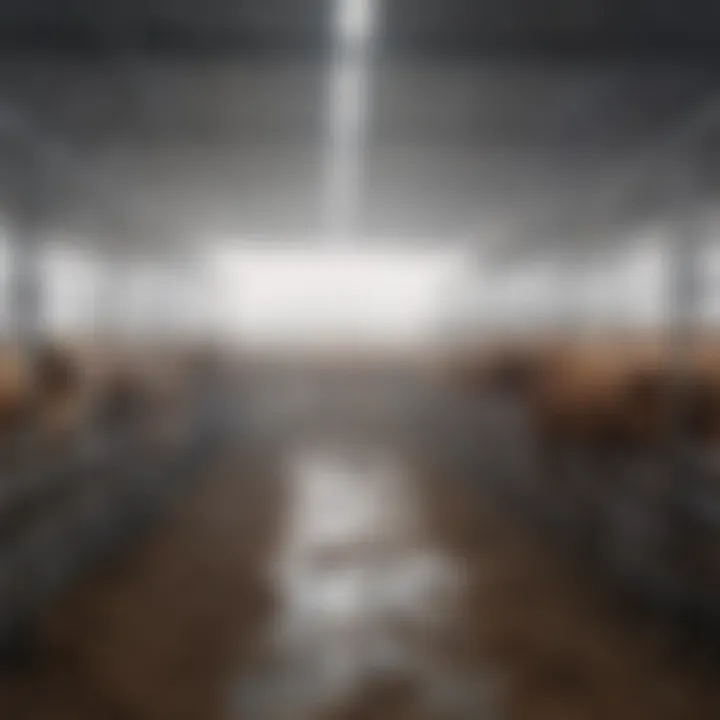
- Excavation and Ground Prep: Initial excavation must be done carefully to accommodate pipes and troughs, ensuring that they are at the appropriate depth to avoid freezing during winter.
- Pipe Installation: Proper installation of pipes should follow established guidelines to maintain optimal flow and reduce the possibility for leaks.
- Heat Integration: If a heating system is part of the design, techniques for safe and effective installation must be detailed to ensure compliance.
- Testing: After installation, conducting system tests before full operation is vital. This includes checking for leaks and ensuring mechanisms respond correctly to temperature changes.
In summary, engaging rigorous installation techniques and thorough assessments can maximize the system's performance, translating into better water access for cattle even in severe weather conditions.
Maintenance of Freeze Proof Systems
Maintaining freeze proof cattle watering systems is essential to ensure they function properly in cold weather. Regular attention to these systems not only supports livestock welfare but also extends the lifespan of the equipment. Proper maintenance reduces the risk of unexpected failures that can lead to livestock dehydration. Thus, it is crucial for farmers to adopt structured practices that address inspection, cleaning, and quick troubleshooting of issues.
Regular Inspection Practices
Routine inspections should be a priority for anyone operating freeze proof watering systems. An effective inspection routine involves checking various components, from heating elements to insulation and piping. Timely detection of signs like rust, wear, or damage can prevent larger issues down the line. Here are some focused steps:
- Visual Checks: Regularly inspect for leaks or cracks in hardware.
- Temperature Monitoring: Utilize thermometers to verify that water remains above freezing points.
- Component Testing: Check heated systems for functionality by ensuring heaters activate properly.
Adopting a seasonal strategy can be more effective. Conduct more comprehensive checks before winter, ensuring equipment is fully operational when temperatures drop. Consider documenting findings for accountability.
Cleaning Procedures
Cleaning is vital in maintenance to ensure the system remains functional and free of contaminants. Buildup of sediment, algae, or debris can affect water quality and system efficiency. Cleaning procedures might include:
- Draining the System: Remove any standing water before cleaning.
- Scrubbing Troughs and Tanks: Use non-toxic cleaners or a vinegar solution to avoid chemical residues. This helps remove dirt and biofilm.
- Flushing Piping: Regularly flush lines with water to clear out blockages or buildup.
Keep in mind that cleaning intervals may vary based on climate and system use. A cleaner system not only ensures better water quality for livestock but also enhances the system's performance and longevity.
Troubleshooting Common Issues
Even well-maintained systems may experience issues. Being prepared to troubleshoot can prevent minor problems from escalating. Here are some common challenges and solutions:
- Heating Malfunctions: If the heating element does not activate, ensure electrical connections are secure. Replace defective parts as necessary.
- Insufficient Water Flow: This might indicate blockages. Inspect and clear any obstructions in pipes or troughs.
- Freezing Water: If water freezes in troughs, check insulation and determine if additional heating solutions are needed.
A systematic approach to troubleshooting helps prevent downtime and maintain an uninterrupted water source for livestock. Familiarize yourself with each component's function to enhance problem-solving efficiency.
"Routine maintenance not only ensures the proper function of freeze proof systems but can also enhance livestock welfare through reliable water access."
In summary, effective maintenance practices for freeze proof cattle watering systems are a combination of inspections, cleaning routines, and proactive troubleshooting. By prioritizing these actions, farmers can secure quality water access, which is vital for livestock, even under challenging weather conditions.
Economic Considerations
Understanding the economic considerations surrounding freeze proof cattle watering systems is essential for farmers and agricultural professionals. The investment in these systems not only affects the immediate budget but also has long-term implications on operation efficiency, livestock health, and overall profitability. The key elements in this section include a cost analysis of installation, the long-term operating costs, and the return on investment that such systems offer.
Cost Analysis of Installation
When evaluating the installation of freeze proof cattle watering systems, the initial costs are a major element to consider. Several factors determine these costs:
- Type of System Chosen: Different systems, such as heated water troughs or self-contained systems, come with their own price tags. Complex systems generally require higher upfront investments.
- Site Preparation: The necessary groundwork for proper installation can add to costs. Considerations might involve excavation, electrical work, or additional water line installations.
- Professional Labor: Hiring skilled professionals for installation is often needed. Although this can increase the immediate expense, it can also ensure proper setup, which may prevent future breakdowns.
The total costs will vary, but making a detailed cost analysis is crucial to ensure budget alignment and readiness for potential unforeseen expenses.
Long-term Operating Costs
Beyond the initial investment, ongoing operating costs should be a key factor in evaluating the systems.
- Energy Costs: Many freeze proof watering systems utilize heating elements that require electrical power. The energy prices in the area can substantially impact these operating costs.
- Maintenance Requirements: Regular maintenance tasks, such as checking heating elements and cleaning troughs, incur labor and material costs. These can vary based on system design and local service rates.
- Longevity of Materials: The quality of materials used will directly influence long-term costs. Investing in durable insulation and heating components can save users significant expenses by prolonging system life.
Keeping track of these costs regularly can provide insight into the overall affordability and functionality of the system over time.
Return on Investment
Evaluating the return on investment (ROI) offers a clear perspective on the financial efficacy of freeze proof cattle watering systems.
- Increased Livestock Productivity: Better water access leads to improved hydration, which is essential for cattle health. Healthier livestock can yield higher production in terms of milk or beef.
- Reduced Labor Costs: Automating watering systems means less labor is needed to monitor and refill water. This can enable farm personnel to focus on other areas.
- Energy Efficiency Improvements: By selecting advanced heating technologies and insulated designs, farmers can often reduce heating costs over time. This enhances ROI by cutting down on energy expenses.
Often, the most effective opportunities for economic benefits lie not just in direct savings but also in maximizing livestock productivity and minimizing labor costs.
In summary, the economic considerations related to freeze proof cattle watering systems encompass initial installation costs, ongoing operational expenses, and the potential return on investment. Farmers can make informed decisions that align with their financial goals and operational needs by carefully analyzing these components.
Environmental Impacts
Understanding the environmental impacts of freeze proof cattle watering systems is crucial for modern agriculture. These systems, while primarily designed for the welfare of livestock, also have significant implications for sustainability and ecological balance. As farmers and agricultural professionals consider their cattle watering solutions, it is imperative to recognize how these systems can contribute to conservation and minimize environmental footprints.
Water Conservation Strategies
Implementing effective water conservation strategies is not just beneficial for livestock; it also helps preserve this vital resource for future generations. Freeze proof systems can be designed to optimize water use. For instance, by incorporating features like automatic shut-off valves, these systems ensure that water flows only when necessary. Moreover, rainwater collection can be integrated into the design for supplementing cattle water needs and reducing reliance on ground sources.
- Rainwater Harvesting: Capturing rainwater can supplement traditional water sources, ensuring that cattle have adequate supply without over-extraction from local aquifers.
- Water Recycling: Systems that allow for captured runoff to be treated and reused are becoming more prevalent. This process not only conserves water but can also improve the overall hygiene of the water supply.
Minimizing Waste in Operations
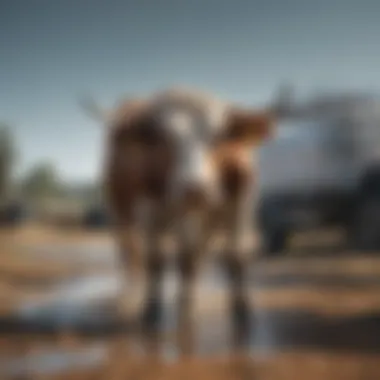

Minimizing waste is a core element in the operation of freeze proof cattle watering systems. Efficient systems reduce not just water loss but also energy consumption. For instance, self-regulating systems that monitor environmental conditions can significantly cut down on energy used for heating. Similarly, using insulated pipes minimizes heat loss, further enhancing efficiency.
- Regular Maintenance: Routine checks can prevent leaks and other issues that lead to waste. Keeping systems in optimal condition prolongs their life and reduces waste generated during repairs.
- Smart Watering Schedules: Implementing time-based watering intake can also decrease water usage, ensuring cows are hydrated without flooding their areas.
Ecosystem Considerations
The interaction between cattle watering systems and surrounding ecosystems warrants careful attention. These systems should be designed with the local wildlife and environment in mind to prevent negative impacts. For instance, poorly designed trough placements can lead to soil erosion and damage to habitats.
- Wildlife Friendly Design: Creating watering areas that allow access for wildlife can help maintain local animal populations while meeting livestock needs.
- Impact Assessments: Conducting thorough assessments before installation can reveal potential ecological disruptions, allowing for better planning and environmentally friendly solutions.
"Sustainable agricultural practices can enhance both livestock welfare and environmental integrity."
Emerging Technologies in Cattle Watering Systems
Emerging technologies in cattle watering systems represent a significant advancement in agricultural practices. These innovations address the challenges of maintaining a consistent and reliable water supply for livestock, especially during extreme weather conditions. In particular, advancements such as automated solutions, smart farming integration, and new material innovations are crucial in modern farming. They not only enhance efficiency but also contribute to better overall animal welfare.
Automated Watering Solutions
Automated watering systems have revolutionized how farmers manage water access for their cattle. These systems allow for consistent water distribution with minimal human intervention. For example, electronically controlled watering troughs can sense when water levels drop and automatically refill. This automation reduces labor costs and ensures that livestock always have access to fresh water, crucial for their health and productivity. Furthermore, some systems can even monitor water temperature and quality, sending alerts if there are any issues.
Advantages of automated systems include:
- Time Efficiency: Reduces the amount of labor needed to tend to watering needs.
- Consistent Water Quality: Maintains optimal conditions for livestock health.
- Detailed Monitoring: Provides data on water usage, helping in resource management.
Integration with Smart Farming Systems
The integration of cattle watering systems with smart farming technologies has become increasingly relevant. By connecting watering systems to a central management platform, farmers can oversee multiple aspects of their operation. This includes tracking water usage, monitoring environmental conditions, and managing feed and health records, all from a single interface.
The benefits of this integration are notable:
- Data-Driven Decisions: Access to real-time data enables better decision-making.
- Resource Optimization: Efficient water usage reduces waste and lowers costs.
- Predictive Maintenance: Early identification of system issues can prevent breakdowns, ensuring uninterrupted water supply.
Innovations in Materials
Material innovations have also played a pivotal role in the development of freeze proof cattle watering systems. Traditional materials may struggle with temperature regulation, leading to ice formation in colder climates. New materials, such as advanced polymers and composites, offer better insulation properties and are designed to withstand extreme temperatures.
Key aspects of these material innovations include:
- Durability: Modern materials are often lighter and more resistant to wear and tear.
- Thermal Efficiency: Enhanced insulation reduces the energy needed for heating solutions, lowering operational costs.
- Environmentally Friendly Options: Some materials are designed for sustainability, aligning with eco-conscious farming practices.
Best Practices for Implementation
The effective implementation of freeze proof cattle watering systems is vital for ensuring that livestock have continuous access to water during cold months. Selecting the appropriate systems and techniques significantly impacts the overall welfare of animals as well as operational efficiency. This section focuses on the key practices that should be considered to enhance the functionality and reliability of these systems.
Choosing the Right System
When selecting a freeze proof watering system, it is crucial to evaluate the specific needs of your operation. Different systems offer various advantages depending on factors such as size of the herd, climate conditions, and budget. Some important considerations include:
- System Type: Options like heated troughs or self-contained units may be ideal for small to medium-sized herds, providing ease of use and maintenance. Conversely, larger operations might benefit from gravity-fed solutions that leverage existing water sources.
- Reliable Energy Sources: The availability of electricity or alternative energy solutions can influence system choice. Systems powered by renewables, like solar panels, can offer sustainability benefits.
- Durability and Maintenance: Assess the materials and construction of the system to ensure it can withstand adverse weather. Devices that require less maintenance can save time and reduce costs in the long run.
Choosing wisely not only safeguards the water supply but also enhances operational efficiency.
Adapting to Local Climate Conditions
Different geographical regions experience varying temperatures and precipitation levels. Understanding the local climate is key when implementing freeze proof watering systems. Here are some points to consider:
- Temperature Fluctuations: In areas with extreme cold, systems with adequate heating mechanisms may be necessary. If temperatures regularly drop below freezing, investing in a heating element is critical.
- Humidity and Precipitation: High humidity levels may affect materials used in construction and installation procedures. Ensuring that materials are suited for local conditions supports longevity and functionality.
- Winter Preparation: Seasonal checks and pre-winter preparations are essential. Conducting routine maintenance before winter helps identify any potential issues, ensuring that systems function flawlessly when weather turns cold.
By adapting watering systems to local conditions, farmers can prevent losses from ice formation and ensure livestock have a reliable water source.
Scaling Solutions for Large Operations
As operations grow, the complexity of managing freeze proof watering systems increases. Scaling solutions requires careful planning and implementation. Considerations for scaling include:
- Layout Planning: A well-designed layout ensures that troughs are spaced efficiently and connected to water supplies. This minimization of dead-end lines can reduce chances for freezing.
- Volume Demand: Understanding the water needs of a larger herd can help in choosing the right size and number of watering units. Systems must be capable of meeting peak demands without interruption.
- Labor Requirements: Automation may be necessary when operating systems at a large scale. Automated watering solutions can reduce labor time and ensure consistent management of water supply.
Scaling requires a holistic approach to ensure that all aspects of the operations are synchronized and that livestock have reliable access to water regardless of size.
Culmination
The pivotal role of freeze proof cattle watering systems lies in their undeniable influence on livestock welfare, especially in colder climates. Ensuring consistent and accessible water supply for cattle is not merely a matter of convenience; it has profound implications on their health, productivity, and overall ranch success.
Reflections on Water Accessibility for Livestock
Access to water is the cornerstone of livestock management. Cattle must have a continuous supply to maintain hydration, especially when environmental temperatures drop. When water sources freeze or become unmanageable due to harsh weather, it can lead to stress and health issues among the animals.
Besides, the physical exertion required for the animals to reach water can worsen with snow or icy conditions, complicating their feed intake. Thus, an effective freeze proof watering system ultimately leads to better growth, improved fertility rates, and reduced veterinary costs. Ranchers must be proactive in ensuring water systems are not only installed but also regularly maintained and adapted to specific conditions to avoid detrimental impacts on livestock.
Future Directions in Cattle Watering Systems
The future of freeze proof cattle watering systems embraces innovation and technological advancement. As ranchers explore options, integrative solutions that utilize smart farming technology can provide efficiencies hitherto unseen.
- Automated mechanisms: Automatic sensors that monitor water levels and temperatures can significantly reduce the workload on farmers, ensuring cattle always have accessible water without manual checks.
- Renewable energy sources: The integration of solar heaters and wind-powered devices can drive sustainable practices in watering systems, lowering costs in the long term.
- Enhanced materials: Research continues into developing superior insulative materials which can improve the efficiency of current designs, retaining heat better with less energy consumption.
The incorporation of these developments will not only help improve the quality of livestock care but could also lead to more sustainable farming practices. As we progress, continuous evaluation and adjustment of these systems will be crucial in meeting future challenges.



